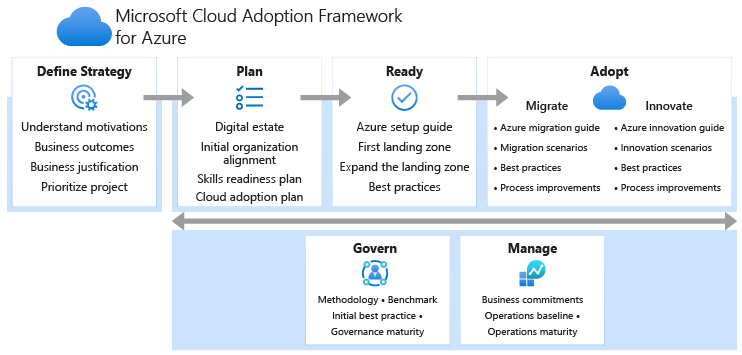
The Cloud Adoption Framework is a guide for the full lifecycle of cloud adoption. It helps apply various guidance, tools, best practices, and reference architectures within each of the methodologies. Before using CAF, you should have a general understanding of your current cloud adoption plan and of course an understanding of Azure.
Who should care about CAF
The goal of the CAF in my opinion is leveraging all levels of a business. It is not limited to, but it takes leaders, business decision-makers, IT decision-makers, finance, developers, operations, and so much more to start a cloud journey. We know that a business depends on its workforce and each person has different objectives or performance areas. Thus a single user can’t be solely responsible for all the aspects of the CAF.
What I often find missing within the journey to the cloud is a centralized team that keeps the standard and growing business on track. It really doesn’t matter what the team is called, but over the last several years it has been called. Cloud Center of Excellence (CCoE).
CCoE main goal is to make the cloud adoption smooth as possible when migrating new or existing workflow into the cloud. It must start with executive leadership support and gain visibility throughout the business. I will deep dive into that in another blog post here.
Challenges/Blockers
One thing that the CCoE team should try to avoid is challenges and blockers.
- Establish teams: Depending on your adoption strategy and operating model, you might need to establish a few teams. This section helps you get those new teams started, or redistribute duties if a dedicated team isn’t needed.
- Improve controls: As adoption of the cloud grows, you need a solid operating model to ensure wise decisions and proper organizational change. Align people and improve operations to develop your cloud operating model.
- Accelerate adoption: Cloud adoption requires technical change, but to digitally transform with the cloud, it requires more than just IT. Use these guides to start aligning various teams to accelerate migration and innovation efforts.
- Align foundation: Your company’s cloud is built on a set of foundational decisions that can impact all cloud-based outcomes. This guide and conceptual information can help you make core decisions and document them.
Methodologies of CAF
Understanding the entire cloud adoption lifecycle can be daunting. Thus, Microsoft has broken it down into variety of pillars (strategy – plan – ready – adopt – govern – manage). Each designed area is to help a specific role deliver a defined function. What is missing from the diagram is what I have already outlined above with the CCoE is the Organize pillar.

Organize
Strategy
Documenting the cloud strategy will help business stakeholders and technicians understand the benefits the business is pursuing by adopting the cloud. Finding out the key motivations and outcomes will help define goals to achieve a successful cloud migration. such as will the business is migrating current workloads or will you simply build all new workloads within the cloud.
What are your business goals, drivers, opportunities?
How do we get started?
How do we ensure security in the cloud?
Are we migrating as is a rehost (Lift&Shift) or will we optimize (refractor) using cloud-native tooling?
Do we innovate, by building new in/for the cloud?
Plan
Cloud adoption plans convert the aspirational goals of the cloud adoption strategy into actions. It will help guide technical efforts, in alignment with the business strategy
aka.ms/adopt/plan
Ready
Ready establishes a cloud foundation or Adoption Target that can provide hosting for any adoption efforts. This should consist of common denominators across 80–90% of cloud adoption.
Adopt
Cloud adoption will include workloads which do not warrant significant investments in the creation of new business logic. These workloads are candidates for migration to the cloud.
Adopt: Innovate
Older apps can take advantage of many of the same cloud-native benefits by modernizing the solution or components of the solution. Modern DevOps invites into the process to create shorter feedback loops and better customer experiences.
Governance
Policy definition ensures consistency across adoption efforts. Alignment to governance/compliance requirements is key to maintain a well-managed cloud environment.
Governance is a major part of succeeding within the cloud. Yes, this can be just tossed to the side, but in my experience, this can cause resources to be deployed in different ways. Usually, this is a pain point on-prem, because it because increasingly difficult to manage. No matter the size of the company, this is a major foundation for the whole company. Think about the security, compliance, and cost well focusing on building and deploying products to the end-users.
Manage
Manage and operations enumerates, implements, and iteratively reviews related to the expected operational behavior of the service.
Microsoft Assessments
A digital, self-service customer experience to help navigate the different stages of cloud adoption, that adapts and guides at any stage of being cloudified.
Cloud Journey Tracker
Governance Benchmark
Azure Architecture Review
Migration Assessment & Readiness Tool
Can all be found and tracked at aka.ms/adopt/assess
Resource Link
If you’re new to Azure, begin by reading Get started with the Cloud Adoption Framework. This overview provides best practices for your digital transformation, as it walks you through each step of the process.
- CAF Best Practices
- Tagging
- Tracking
- TCO Calculator
- Cost Management
- Toolchain matrix
1 thought on “Cloud Adoption Framework (CAF) for Azure”